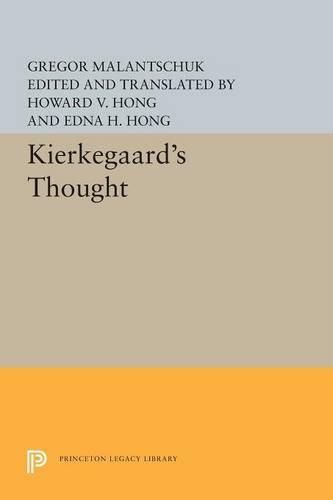Readings Newsletter
Become a Readings Member to make your shopping experience even easier.
Sign in or sign up for free!
You’re not far away from qualifying for FREE standard shipping within Australia
You’ve qualified for FREE standard shipping within Australia
The cart is loading…






Kierkegaard’s pseudonymous authorship has baffled readers, his apparent capriciousness making it difficult to determine his position at a given point and to understand his work as an organic whole. Gregor Malantschuk’s study, based on careful reading of Kierkegaard’s journals, papers, and texts, cuts through the authorship problem to clarify the philosopher’s key ideas, see the comprehensive plan of his work, and make intelligible the dialectical coherence of his thought. Discussing Kierkegaard’s dialectical method and his use of it from Either/Or to the final Two Discourses, Professor Malantschuk shows how coherently Kierkegaard set the individual works in place, so that even the conflict between the principal pseudonyms, Climacus and Anti-Climacus, serves to elucidate his major philosophical ideas. Contents: 1. Anthropological Contemplation. II. Kierkegaard’s Dialectical Method. III. The Dialectic Employed in the Authorship. Index. Originally published in 1971. The Princeton Legacy Library uses the latest print-on-demand technology to again make available previously out-of-print books from the distinguished backlist of Princeton University Press. These editions preserve the original texts of these important books while presenting them in durable paperback and hardcover editions. The goal of the Princeton Legacy Library is to vastly increase access to the rich scholarly heritage found in the thousands of books published by Princeton University Press since its founding in 1905.
$9.00 standard shipping within Australia
FREE standard shipping within Australia for orders over $100.00
Express & International shipping calculated at checkout
Kierkegaard’s pseudonymous authorship has baffled readers, his apparent capriciousness making it difficult to determine his position at a given point and to understand his work as an organic whole. Gregor Malantschuk’s study, based on careful reading of Kierkegaard’s journals, papers, and texts, cuts through the authorship problem to clarify the philosopher’s key ideas, see the comprehensive plan of his work, and make intelligible the dialectical coherence of his thought. Discussing Kierkegaard’s dialectical method and his use of it from Either/Or to the final Two Discourses, Professor Malantschuk shows how coherently Kierkegaard set the individual works in place, so that even the conflict between the principal pseudonyms, Climacus and Anti-Climacus, serves to elucidate his major philosophical ideas. Contents: 1. Anthropological Contemplation. II. Kierkegaard’s Dialectical Method. III. The Dialectic Employed in the Authorship. Index. Originally published in 1971. The Princeton Legacy Library uses the latest print-on-demand technology to again make available previously out-of-print books from the distinguished backlist of Princeton University Press. These editions preserve the original texts of these important books while presenting them in durable paperback and hardcover editions. The goal of the Princeton Legacy Library is to vastly increase access to the rich scholarly heritage found in the thousands of books published by Princeton University Press since its founding in 1905.